Community Nursing Risks: Identifying and Addressing Safety Concerns
VerifiedAdded on 2023/06/04
|12
|3237
|414
Report
AI Summary
This report addresses the risks associated with community nursing, focusing on the challenges faced by nurses in providing home healthcare services. It examines the functions of community nurses, highlighting their roles in assessing patient needs and connecting them with appropriate support services. The report delves into specific risks, including those related to caring for mental health patients, where nurses may encounter aggression and violence, and the challenges of geriatric care, such as managing dementia, ensuring patient self-care, and addressing abuse and neglect. The analysis emphasizes the need for organizational protocols to ensure nurse safety and patient well-being. The report reviews relevant literature to support the findings.
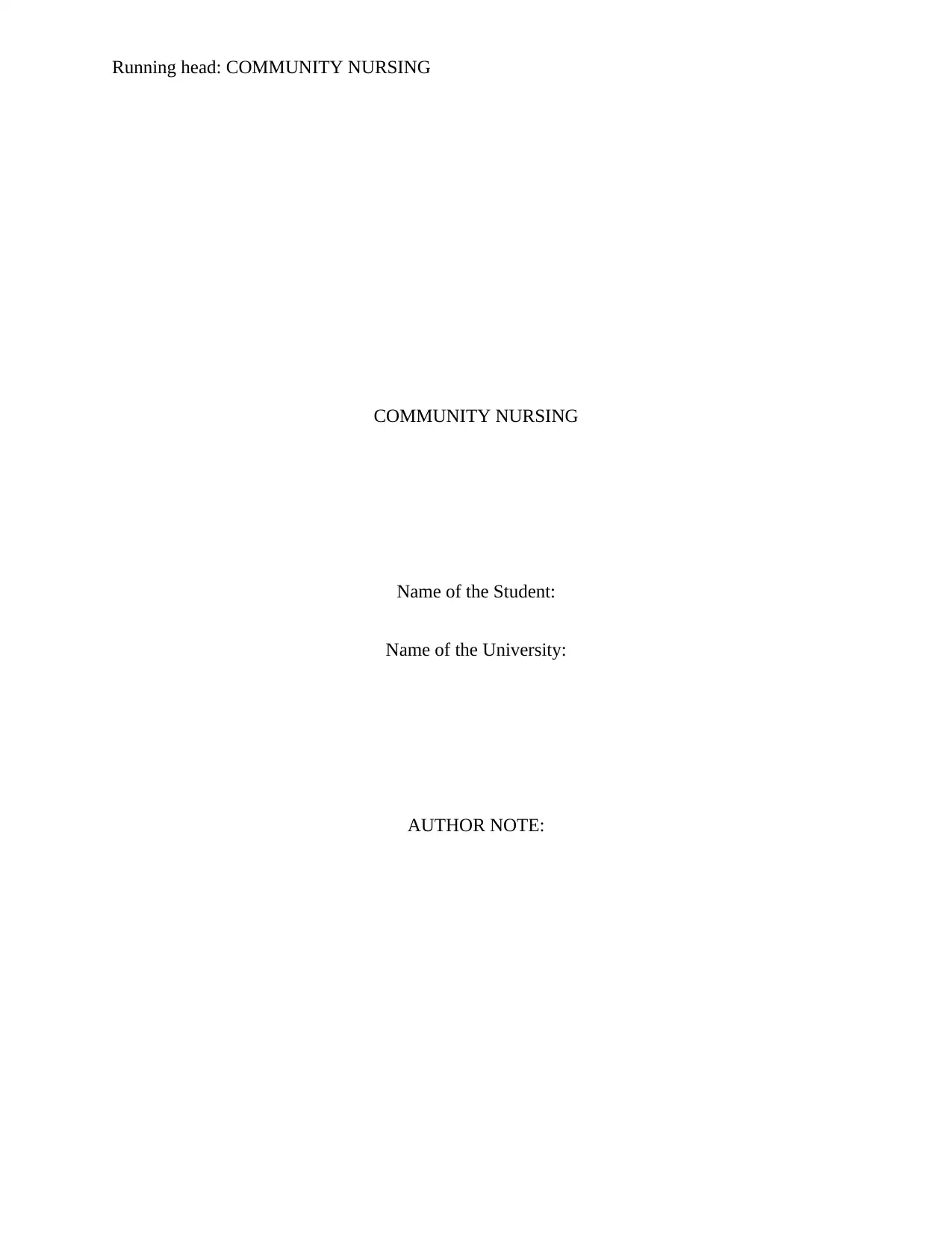
Running head: COMMUNITY NURSING
COMMUNITY NURSING
Name of the Student:
Name of the University:
AUTHOR NOTE:
COMMUNITY NURSING
Name of the Student:
Name of the University:
AUTHOR NOTE:
Paraphrase This Document
Need a fresh take? Get an instant paraphrase of this document with our AI Paraphraser
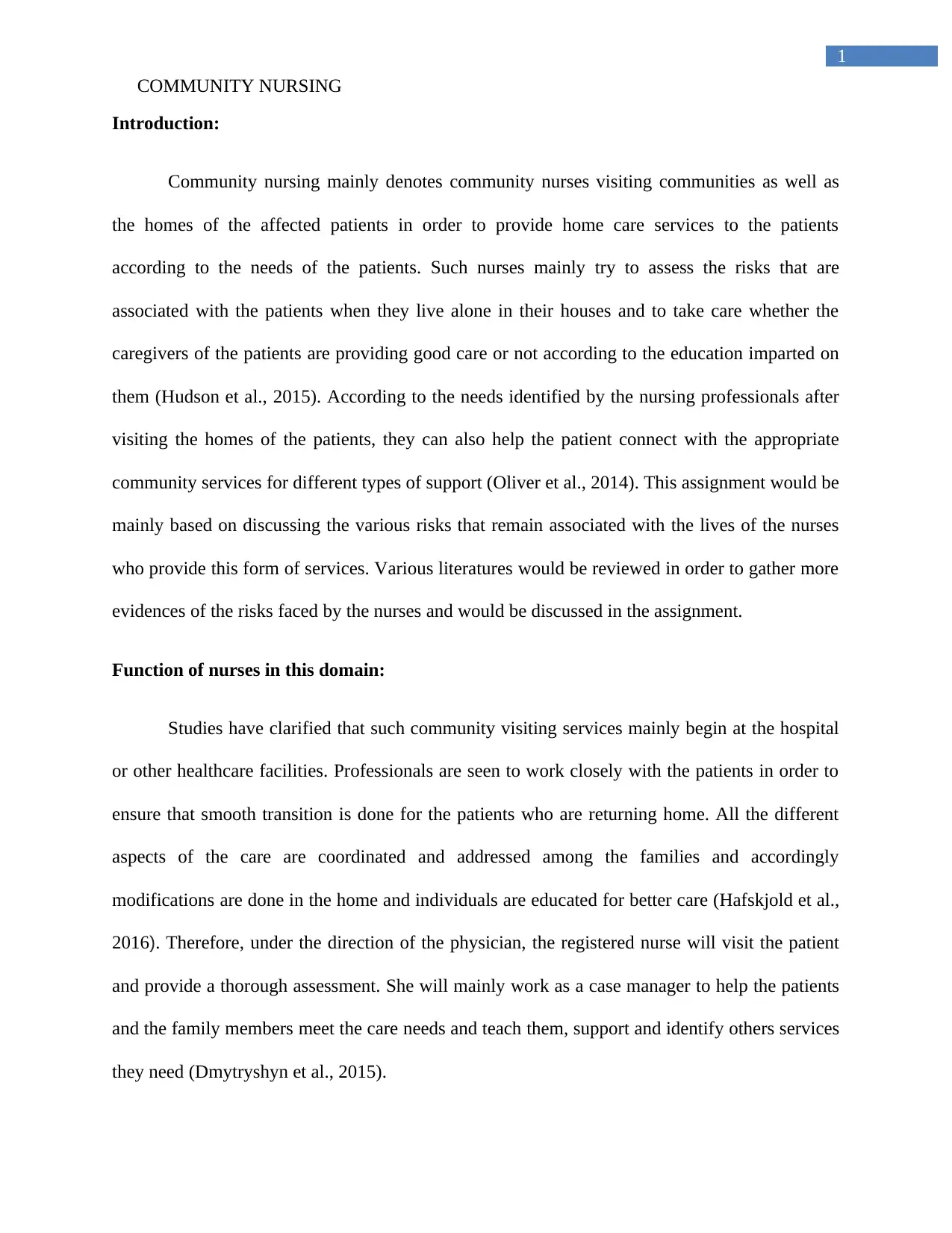
1
COMMUNITY NURSING
Introduction:
Community nursing mainly denotes community nurses visiting communities as well as
the homes of the affected patients in order to provide home care services to the patients
according to the needs of the patients. Such nurses mainly try to assess the risks that are
associated with the patients when they live alone in their houses and to take care whether the
caregivers of the patients are providing good care or not according to the education imparted on
them (Hudson et al., 2015). According to the needs identified by the nursing professionals after
visiting the homes of the patients, they can also help the patient connect with the appropriate
community services for different types of support (Oliver et al., 2014). This assignment would be
mainly based on discussing the various risks that remain associated with the lives of the nurses
who provide this form of services. Various literatures would be reviewed in order to gather more
evidences of the risks faced by the nurses and would be discussed in the assignment.
Function of nurses in this domain:
Studies have clarified that such community visiting services mainly begin at the hospital
or other healthcare facilities. Professionals are seen to work closely with the patients in order to
ensure that smooth transition is done for the patients who are returning home. All the different
aspects of the care are coordinated and addressed among the families and accordingly
modifications are done in the home and individuals are educated for better care (Hafskjold et al.,
2016). Therefore, under the direction of the physician, the registered nurse will visit the patient
and provide a thorough assessment. She will mainly work as a case manager to help the patients
and the family members meet the care needs and teach them, support and identify others services
they need (Dmytryshyn et al., 2015).
COMMUNITY NURSING
Introduction:
Community nursing mainly denotes community nurses visiting communities as well as
the homes of the affected patients in order to provide home care services to the patients
according to the needs of the patients. Such nurses mainly try to assess the risks that are
associated with the patients when they live alone in their houses and to take care whether the
caregivers of the patients are providing good care or not according to the education imparted on
them (Hudson et al., 2015). According to the needs identified by the nursing professionals after
visiting the homes of the patients, they can also help the patient connect with the appropriate
community services for different types of support (Oliver et al., 2014). This assignment would be
mainly based on discussing the various risks that remain associated with the lives of the nurses
who provide this form of services. Various literatures would be reviewed in order to gather more
evidences of the risks faced by the nurses and would be discussed in the assignment.
Function of nurses in this domain:
Studies have clarified that such community visiting services mainly begin at the hospital
or other healthcare facilities. Professionals are seen to work closely with the patients in order to
ensure that smooth transition is done for the patients who are returning home. All the different
aspects of the care are coordinated and addressed among the families and accordingly
modifications are done in the home and individuals are educated for better care (Hafskjold et al.,
2016). Therefore, under the direction of the physician, the registered nurse will visit the patient
and provide a thorough assessment. She will mainly work as a case manager to help the patients
and the family members meet the care needs and teach them, support and identify others services
they need (Dmytryshyn et al., 2015).
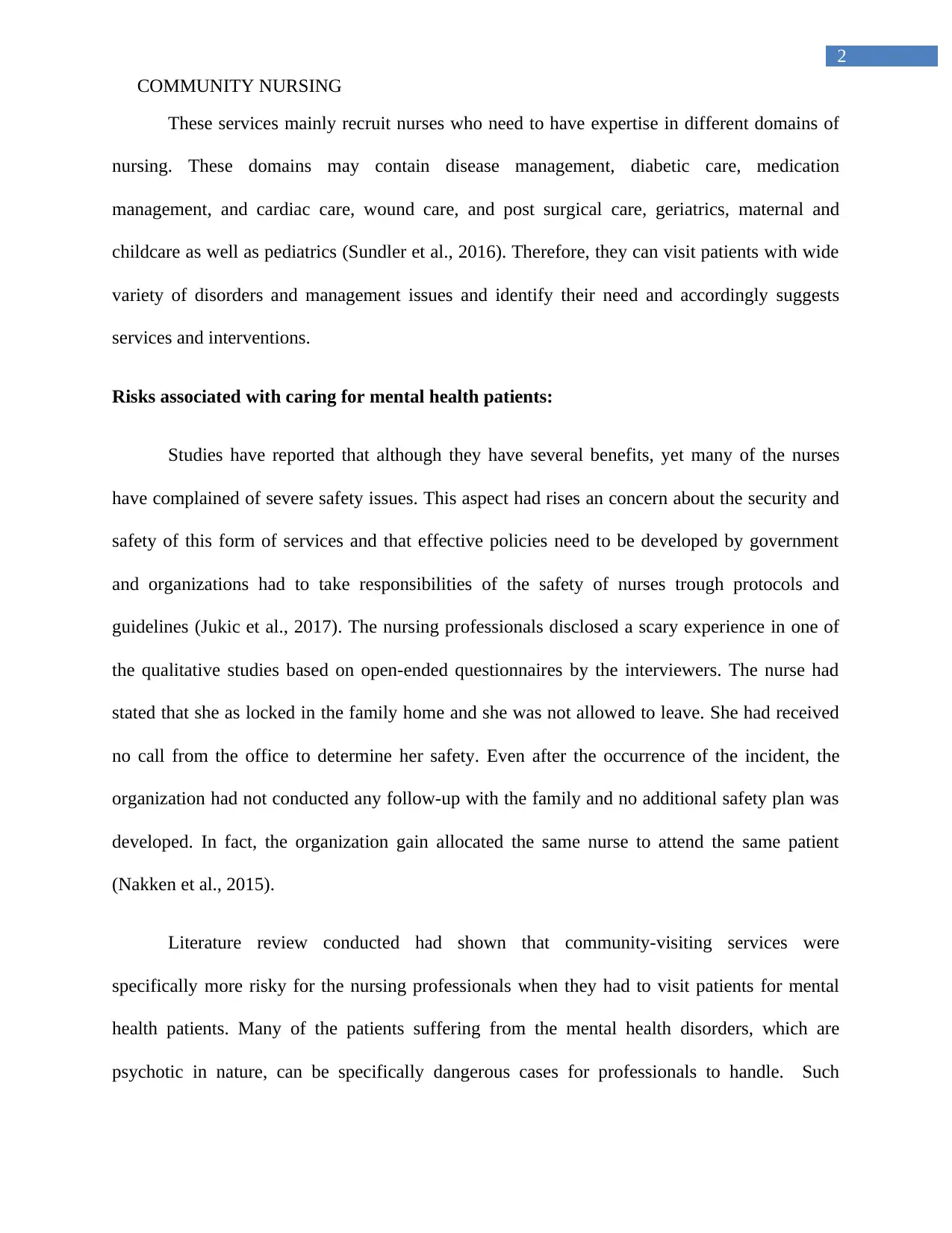
2
COMMUNITY NURSING
These services mainly recruit nurses who need to have expertise in different domains of
nursing. These domains may contain disease management, diabetic care, medication
management, and cardiac care, wound care, and post surgical care, geriatrics, maternal and
childcare as well as pediatrics (Sundler et al., 2016). Therefore, they can visit patients with wide
variety of disorders and management issues and identify their need and accordingly suggests
services and interventions.
Risks associated with caring for mental health patients:
Studies have reported that although they have several benefits, yet many of the nurses
have complained of severe safety issues. This aspect had rises an concern about the security and
safety of this form of services and that effective policies need to be developed by government
and organizations had to take responsibilities of the safety of nurses trough protocols and
guidelines (Jukic et al., 2017). The nursing professionals disclosed a scary experience in one of
the qualitative studies based on open-ended questionnaires by the interviewers. The nurse had
stated that she as locked in the family home and she was not allowed to leave. She had received
no call from the office to determine her safety. Even after the occurrence of the incident, the
organization had not conducted any follow-up with the family and no additional safety plan was
developed. In fact, the organization gain allocated the same nurse to attend the same patient
(Nakken et al., 2015).
Literature review conducted had shown that community-visiting services were
specifically more risky for the nursing professionals when they had to visit patients for mental
health patients. Many of the patients suffering from the mental health disorders, which are
psychotic in nature, can be specifically dangerous cases for professionals to handle. Such
COMMUNITY NURSING
These services mainly recruit nurses who need to have expertise in different domains of
nursing. These domains may contain disease management, diabetic care, medication
management, and cardiac care, wound care, and post surgical care, geriatrics, maternal and
childcare as well as pediatrics (Sundler et al., 2016). Therefore, they can visit patients with wide
variety of disorders and management issues and identify their need and accordingly suggests
services and interventions.
Risks associated with caring for mental health patients:
Studies have reported that although they have several benefits, yet many of the nurses
have complained of severe safety issues. This aspect had rises an concern about the security and
safety of this form of services and that effective policies need to be developed by government
and organizations had to take responsibilities of the safety of nurses trough protocols and
guidelines (Jukic et al., 2017). The nursing professionals disclosed a scary experience in one of
the qualitative studies based on open-ended questionnaires by the interviewers. The nurse had
stated that she as locked in the family home and she was not allowed to leave. She had received
no call from the office to determine her safety. Even after the occurrence of the incident, the
organization had not conducted any follow-up with the family and no additional safety plan was
developed. In fact, the organization gain allocated the same nurse to attend the same patient
(Nakken et al., 2015).
Literature review conducted had shown that community-visiting services were
specifically more risky for the nursing professionals when they had to visit patients for mental
health patients. Many of the patients suffering from the mental health disorders, which are
psychotic in nature, can be specifically dangerous cases for professionals to handle. Such
⊘ This is a preview!⊘
Do you want full access?
Subscribe today to unlock all pages.

Trusted by 1+ million students worldwide

3
COMMUNITY NURSING
situations can expose the nurses to unpredictable events in the house of the patients like that of
aggression and violence on the professionals (Vander et al., 2016). They can be subjected to
physical, mental, emotional as well as verbal violence that might create a concern for the safety
issues of the nurses.
Many of the papers had compared the risk faced by mental health professionals who
provide acute care services to patients in hospitals with that of the community visiting nurses
who visit mental healthcare patients in their homes. Although, both of the nurses were seen to
project being sufferers of violence and aggression form mental health patients, the risks of safety
issues and harm to their health were higher in case of the latter nurses (Wishart et al., 2016) .
Some of the points being opinionated by the researchers for the increased safety issues of the
latter cohort of professionals is the absence of immediate help from the other healthcare
professionals of the team and from the organization providing the services. In the hospitals,
nurses tend to get immediate help from their colleagues and mental support after facing the
incidences. This attribute reduces their anxiety and support their mental condition after facing the
aggression. Any physical harm faced by the professionals is immediately treated. However, such
is not the case of the professionals who are visiting communities or homes for assessing the
unmet needs of the mental health patients and accordingly develop interventions. They also
remain highly vulnerable to violence and aggression but their safety issues remain a huge
concern (Pink et al., 2015). They cannot get any immediate help from other professionals or
organization when the mental health patient attacks the nurse or behaves in an unethical manner.
Such nurses mostly report physical, sexual and verbal assaults and emotional or mental violence
are less. These aspects might harm the professionals physically and mentally affecting their
ability to work and carry on their profession. Such professionals who have faced physical
COMMUNITY NURSING
situations can expose the nurses to unpredictable events in the house of the patients like that of
aggression and violence on the professionals (Vander et al., 2016). They can be subjected to
physical, mental, emotional as well as verbal violence that might create a concern for the safety
issues of the nurses.
Many of the papers had compared the risk faced by mental health professionals who
provide acute care services to patients in hospitals with that of the community visiting nurses
who visit mental healthcare patients in their homes. Although, both of the nurses were seen to
project being sufferers of violence and aggression form mental health patients, the risks of safety
issues and harm to their health were higher in case of the latter nurses (Wishart et al., 2016) .
Some of the points being opinionated by the researchers for the increased safety issues of the
latter cohort of professionals is the absence of immediate help from the other healthcare
professionals of the team and from the organization providing the services. In the hospitals,
nurses tend to get immediate help from their colleagues and mental support after facing the
incidences. This attribute reduces their anxiety and support their mental condition after facing the
aggression. Any physical harm faced by the professionals is immediately treated. However, such
is not the case of the professionals who are visiting communities or homes for assessing the
unmet needs of the mental health patients and accordingly develop interventions. They also
remain highly vulnerable to violence and aggression but their safety issues remain a huge
concern (Pink et al., 2015). They cannot get any immediate help from other professionals or
organization when the mental health patient attacks the nurse or behaves in an unethical manner.
Such nurses mostly report physical, sexual and verbal assaults and emotional or mental violence
are less. These aspects might harm the professionals physically and mentally affecting their
ability to work and carry on their profession. Such professionals who have faced physical
Paraphrase This Document
Need a fresh take? Get an instant paraphrase of this document with our AI Paraphraser
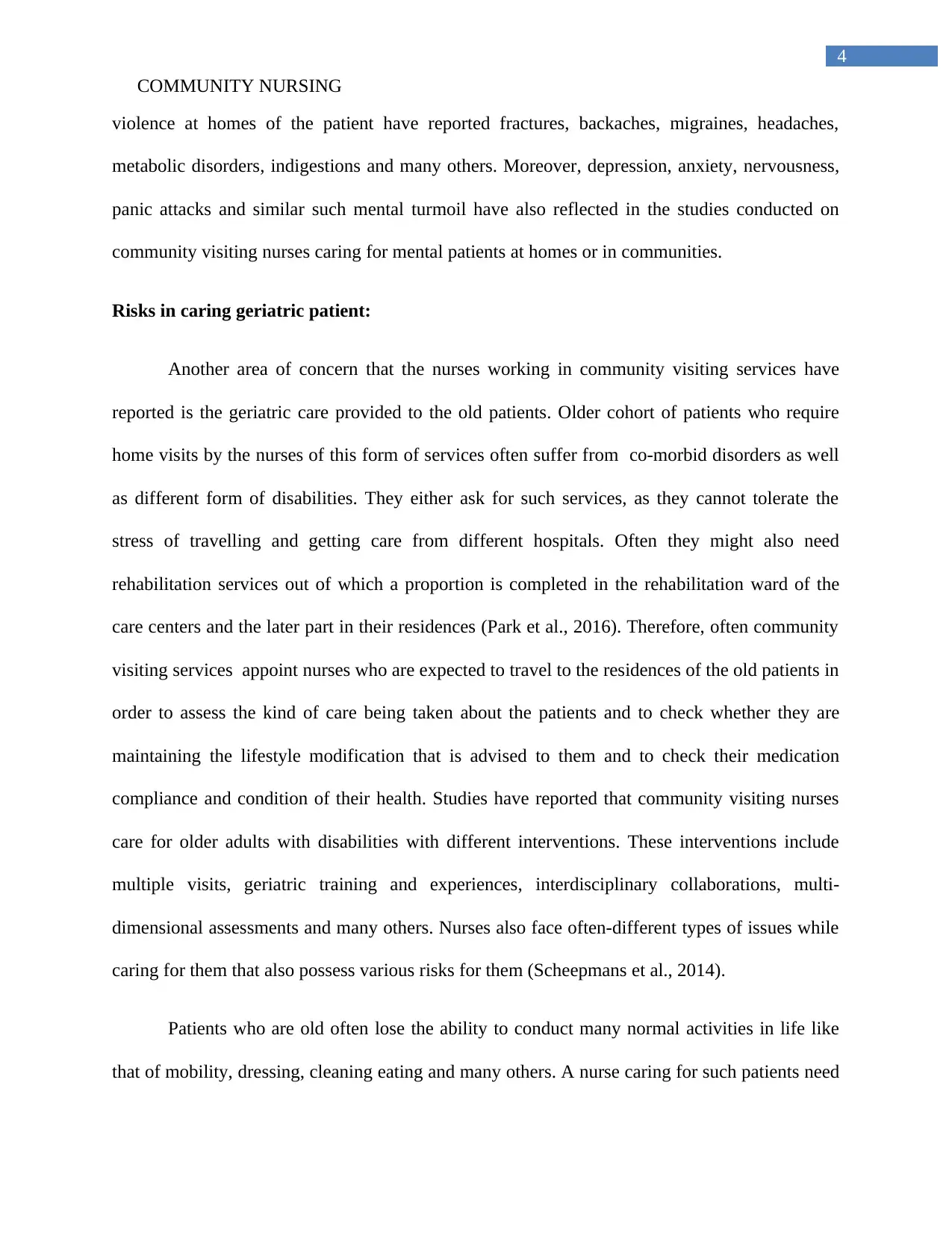
4
COMMUNITY NURSING
violence at homes of the patient have reported fractures, backaches, migraines, headaches,
metabolic disorders, indigestions and many others. Moreover, depression, anxiety, nervousness,
panic attacks and similar such mental turmoil have also reflected in the studies conducted on
community visiting nurses caring for mental patients at homes or in communities.
Risks in caring geriatric patient:
Another area of concern that the nurses working in community visiting services have
reported is the geriatric care provided to the old patients. Older cohort of patients who require
home visits by the nurses of this form of services often suffer from co-morbid disorders as well
as different form of disabilities. They either ask for such services, as they cannot tolerate the
stress of travelling and getting care from different hospitals. Often they might also need
rehabilitation services out of which a proportion is completed in the rehabilitation ward of the
care centers and the later part in their residences (Park et al., 2016). Therefore, often community
visiting services appoint nurses who are expected to travel to the residences of the old patients in
order to assess the kind of care being taken about the patients and to check whether they are
maintaining the lifestyle modification that is advised to them and to check their medication
compliance and condition of their health. Studies have reported that community visiting nurses
care for older adults with disabilities with different interventions. These interventions include
multiple visits, geriatric training and experiences, interdisciplinary collaborations, multi-
dimensional assessments and many others. Nurses also face often-different types of issues while
caring for them that also possess various risks for them (Scheepmans et al., 2014).
Patients who are old often lose the ability to conduct many normal activities in life like
that of mobility, dressing, cleaning eating and many others. A nurse caring for such patients need
COMMUNITY NURSING
violence at homes of the patient have reported fractures, backaches, migraines, headaches,
metabolic disorders, indigestions and many others. Moreover, depression, anxiety, nervousness,
panic attacks and similar such mental turmoil have also reflected in the studies conducted on
community visiting nurses caring for mental patients at homes or in communities.
Risks in caring geriatric patient:
Another area of concern that the nurses working in community visiting services have
reported is the geriatric care provided to the old patients. Older cohort of patients who require
home visits by the nurses of this form of services often suffer from co-morbid disorders as well
as different form of disabilities. They either ask for such services, as they cannot tolerate the
stress of travelling and getting care from different hospitals. Often they might also need
rehabilitation services out of which a proportion is completed in the rehabilitation ward of the
care centers and the later part in their residences (Park et al., 2016). Therefore, often community
visiting services appoint nurses who are expected to travel to the residences of the old patients in
order to assess the kind of care being taken about the patients and to check whether they are
maintaining the lifestyle modification that is advised to them and to check their medication
compliance and condition of their health. Studies have reported that community visiting nurses
care for older adults with disabilities with different interventions. These interventions include
multiple visits, geriatric training and experiences, interdisciplinary collaborations, multi-
dimensional assessments and many others. Nurses also face often-different types of issues while
caring for them that also possess various risks for them (Scheepmans et al., 2014).
Patients who are old often lose the ability to conduct many normal activities in life like
that of mobility, dressing, cleaning eating and many others. A nurse caring for such patients need

5
COMMUNITY NURSING
to not only ensure effective interventions like medication and care plans but also have to conduct
different risk analysis which are not required in other patients suffering from chronic issues.
Therefore, they often feel burdened with more work when they care for geriatric patients that
drain their physical energy and mental stability. Another issue that they also face is the dilemma
and the confusions that the family members face regarding the palliative care of the patients in
end stages (Moir et al., 2015). There are conflicts among the family members about the palliative
care strategies that need to be taken for their old patient and even between the autonomy and
dignity of the old patient and that of the family members. Therefore, nurses need to intervene and
participate in the situation to help them to come to a conclusion and involve strenuous arguments
and decision making sessions. Therefore, this additional work pressures that the professionals
need to handle while caring for the geriatric patients burn them out. They cannot handle the
physical and the mental stress of the work-burden making them to withdraw from the job. This
affects the quality of their life and interrupts their mental stability. Such risk might affect them in
a way by which they leave their jobs, becomes depressed, lose the work-life balance and lose
their confidence (Rest & Hirsch, 2015).
Three other challenges that community visiting nurses also face while caring for the older
people are handling dementia patients, ensuring self-care by the patients and the abuse and
neglect faced by them. People suffering from dementia have memory ailments and therefore,
frequent repetitive instructions need to be given. Extreme patience and calmness are important to
tackle such patients and this attributes make it very difficult for the professionals to handle the
situations as they become frustrated (Wills et al., 2016). In addition to this, care and support also
need to be ensured for the caregivers at the house who care for the patient. Caregivers suffer
from depression, physical ailments like back pains, headaches, fatigues, stress and many others.
COMMUNITY NURSING
to not only ensure effective interventions like medication and care plans but also have to conduct
different risk analysis which are not required in other patients suffering from chronic issues.
Therefore, they often feel burdened with more work when they care for geriatric patients that
drain their physical energy and mental stability. Another issue that they also face is the dilemma
and the confusions that the family members face regarding the palliative care of the patients in
end stages (Moir et al., 2015). There are conflicts among the family members about the palliative
care strategies that need to be taken for their old patient and even between the autonomy and
dignity of the old patient and that of the family members. Therefore, nurses need to intervene and
participate in the situation to help them to come to a conclusion and involve strenuous arguments
and decision making sessions. Therefore, this additional work pressures that the professionals
need to handle while caring for the geriatric patients burn them out. They cannot handle the
physical and the mental stress of the work-burden making them to withdraw from the job. This
affects the quality of their life and interrupts their mental stability. Such risk might affect them in
a way by which they leave their jobs, becomes depressed, lose the work-life balance and lose
their confidence (Rest & Hirsch, 2015).
Three other challenges that community visiting nurses also face while caring for the older
people are handling dementia patients, ensuring self-care by the patients and the abuse and
neglect faced by them. People suffering from dementia have memory ailments and therefore,
frequent repetitive instructions need to be given. Extreme patience and calmness are important to
tackle such patients and this attributes make it very difficult for the professionals to handle the
situations as they become frustrated (Wills et al., 2016). In addition to this, care and support also
need to be ensured for the caregivers at the house who care for the patient. Caregivers suffer
from depression, physical ailments like back pains, headaches, fatigues, stress and many others.
⊘ This is a preview!⊘
Do you want full access?
Subscribe today to unlock all pages.

Trusted by 1+ million students worldwide
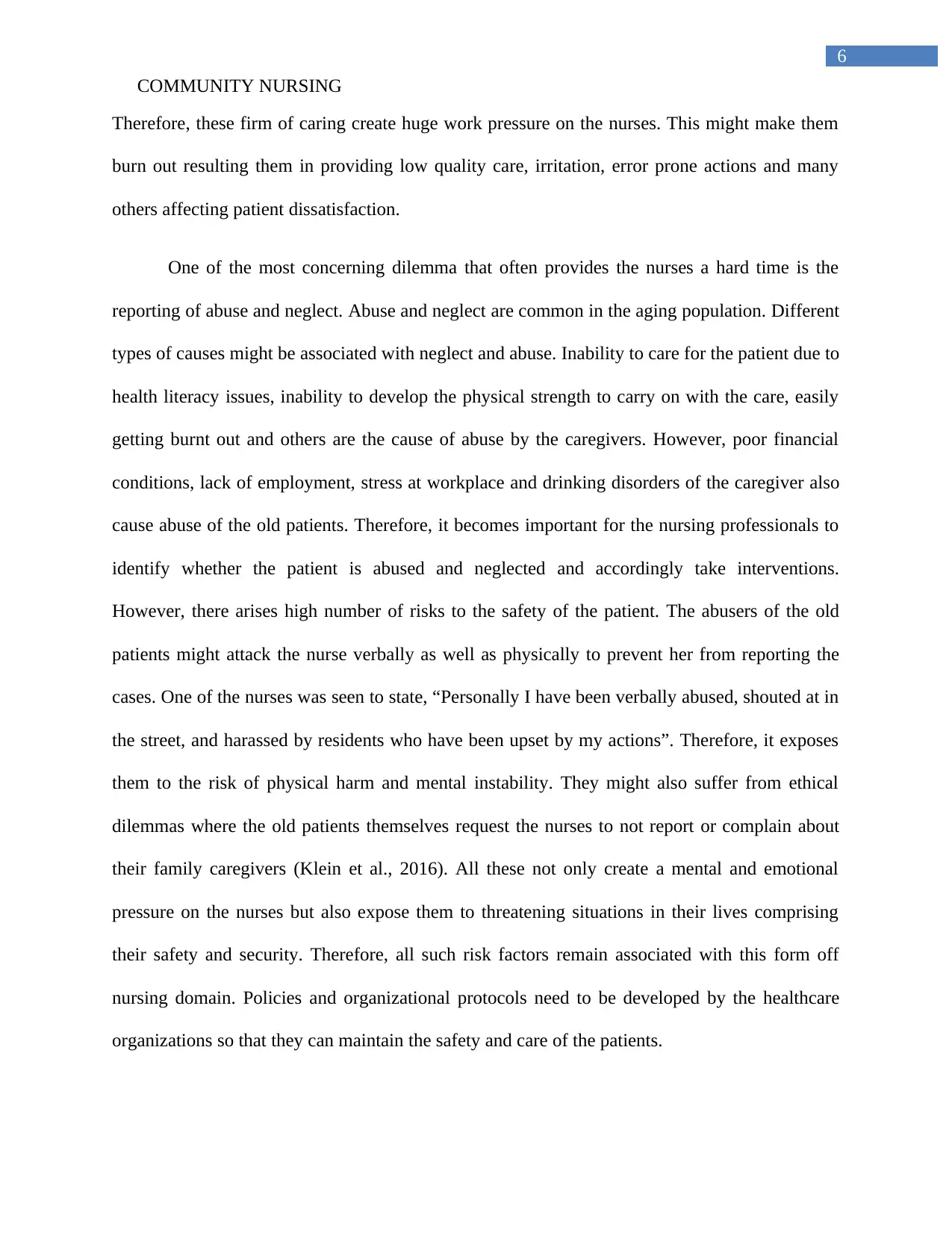
6
COMMUNITY NURSING
Therefore, these firm of caring create huge work pressure on the nurses. This might make them
burn out resulting them in providing low quality care, irritation, error prone actions and many
others affecting patient dissatisfaction.
One of the most concerning dilemma that often provides the nurses a hard time is the
reporting of abuse and neglect. Abuse and neglect are common in the aging population. Different
types of causes might be associated with neglect and abuse. Inability to care for the patient due to
health literacy issues, inability to develop the physical strength to carry on with the care, easily
getting burnt out and others are the cause of abuse by the caregivers. However, poor financial
conditions, lack of employment, stress at workplace and drinking disorders of the caregiver also
cause abuse of the old patients. Therefore, it becomes important for the nursing professionals to
identify whether the patient is abused and neglected and accordingly take interventions.
However, there arises high number of risks to the safety of the patient. The abusers of the old
patients might attack the nurse verbally as well as physically to prevent her from reporting the
cases. One of the nurses was seen to state, “Personally I have been verbally abused, shouted at in
the street, and harassed by residents who have been upset by my actions”. Therefore, it exposes
them to the risk of physical harm and mental instability. They might also suffer from ethical
dilemmas where the old patients themselves request the nurses to not report or complain about
their family caregivers (Klein et al., 2016). All these not only create a mental and emotional
pressure on the nurses but also expose them to threatening situations in their lives comprising
their safety and security. Therefore, all such risk factors remain associated with this form off
nursing domain. Policies and organizational protocols need to be developed by the healthcare
organizations so that they can maintain the safety and care of the patients.
COMMUNITY NURSING
Therefore, these firm of caring create huge work pressure on the nurses. This might make them
burn out resulting them in providing low quality care, irritation, error prone actions and many
others affecting patient dissatisfaction.
One of the most concerning dilemma that often provides the nurses a hard time is the
reporting of abuse and neglect. Abuse and neglect are common in the aging population. Different
types of causes might be associated with neglect and abuse. Inability to care for the patient due to
health literacy issues, inability to develop the physical strength to carry on with the care, easily
getting burnt out and others are the cause of abuse by the caregivers. However, poor financial
conditions, lack of employment, stress at workplace and drinking disorders of the caregiver also
cause abuse of the old patients. Therefore, it becomes important for the nursing professionals to
identify whether the patient is abused and neglected and accordingly take interventions.
However, there arises high number of risks to the safety of the patient. The abusers of the old
patients might attack the nurse verbally as well as physically to prevent her from reporting the
cases. One of the nurses was seen to state, “Personally I have been verbally abused, shouted at in
the street, and harassed by residents who have been upset by my actions”. Therefore, it exposes
them to the risk of physical harm and mental instability. They might also suffer from ethical
dilemmas where the old patients themselves request the nurses to not report or complain about
their family caregivers (Klein et al., 2016). All these not only create a mental and emotional
pressure on the nurses but also expose them to threatening situations in their lives comprising
their safety and security. Therefore, all such risk factors remain associated with this form off
nursing domain. Policies and organizational protocols need to be developed by the healthcare
organizations so that they can maintain the safety and care of the patients.
Paraphrase This Document
Need a fresh take? Get an instant paraphrase of this document with our AI Paraphraser
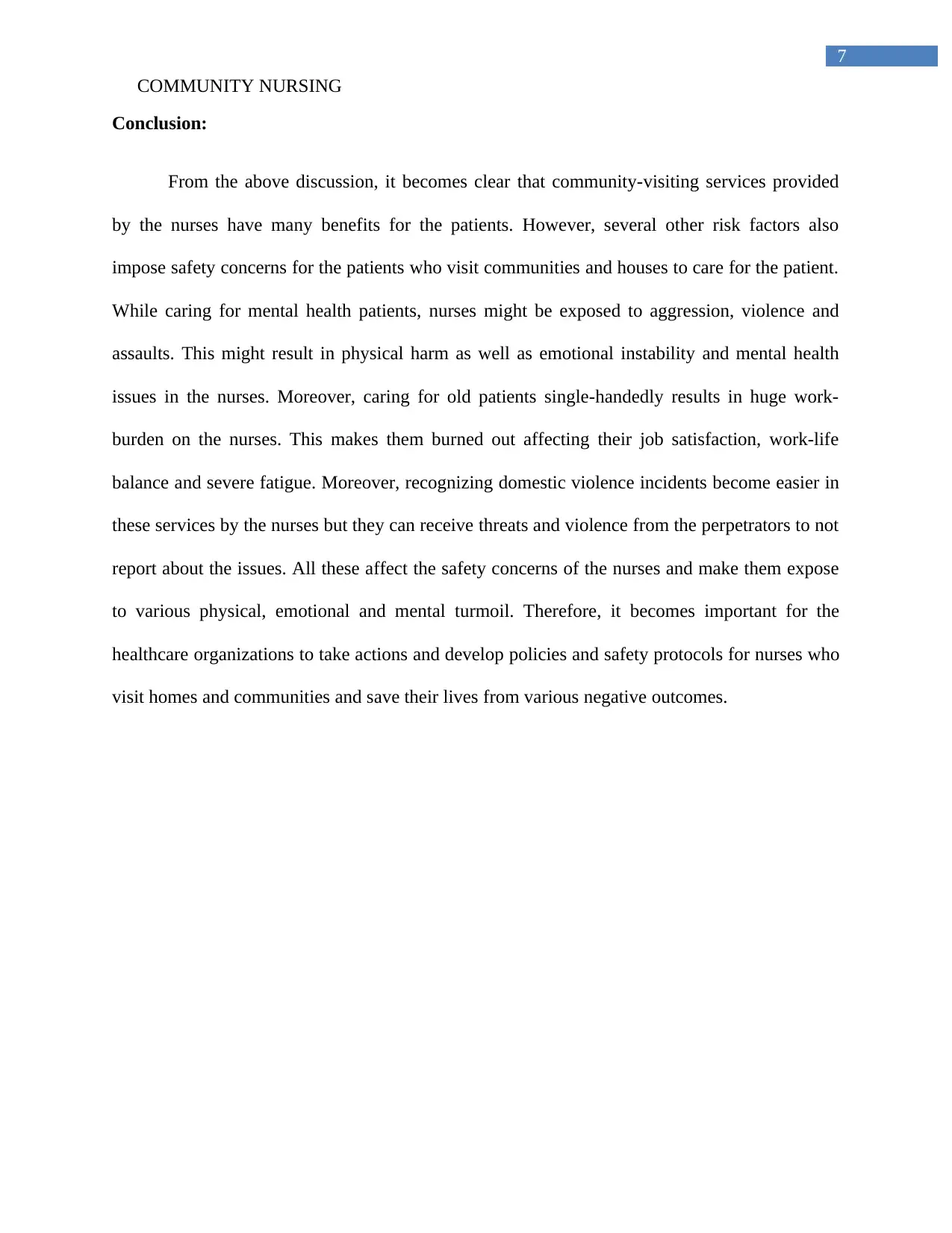
7
COMMUNITY NURSING
Conclusion:
From the above discussion, it becomes clear that community-visiting services provided
by the nurses have many benefits for the patients. However, several other risk factors also
impose safety concerns for the patients who visit communities and houses to care for the patient.
While caring for mental health patients, nurses might be exposed to aggression, violence and
assaults. This might result in physical harm as well as emotional instability and mental health
issues in the nurses. Moreover, caring for old patients single-handedly results in huge work-
burden on the nurses. This makes them burned out affecting their job satisfaction, work-life
balance and severe fatigue. Moreover, recognizing domestic violence incidents become easier in
these services by the nurses but they can receive threats and violence from the perpetrators to not
report about the issues. All these affect the safety concerns of the nurses and make them expose
to various physical, emotional and mental turmoil. Therefore, it becomes important for the
healthcare organizations to take actions and develop policies and safety protocols for nurses who
visit homes and communities and save their lives from various negative outcomes.
COMMUNITY NURSING
Conclusion:
From the above discussion, it becomes clear that community-visiting services provided
by the nurses have many benefits for the patients. However, several other risk factors also
impose safety concerns for the patients who visit communities and houses to care for the patient.
While caring for mental health patients, nurses might be exposed to aggression, violence and
assaults. This might result in physical harm as well as emotional instability and mental health
issues in the nurses. Moreover, caring for old patients single-handedly results in huge work-
burden on the nurses. This makes them burned out affecting their job satisfaction, work-life
balance and severe fatigue. Moreover, recognizing domestic violence incidents become easier in
these services by the nurses but they can receive threats and violence from the perpetrators to not
report about the issues. All these affect the safety concerns of the nurses and make them expose
to various physical, emotional and mental turmoil. Therefore, it becomes important for the
healthcare organizations to take actions and develop policies and safety protocols for nurses who
visit homes and communities and save their lives from various negative outcomes.
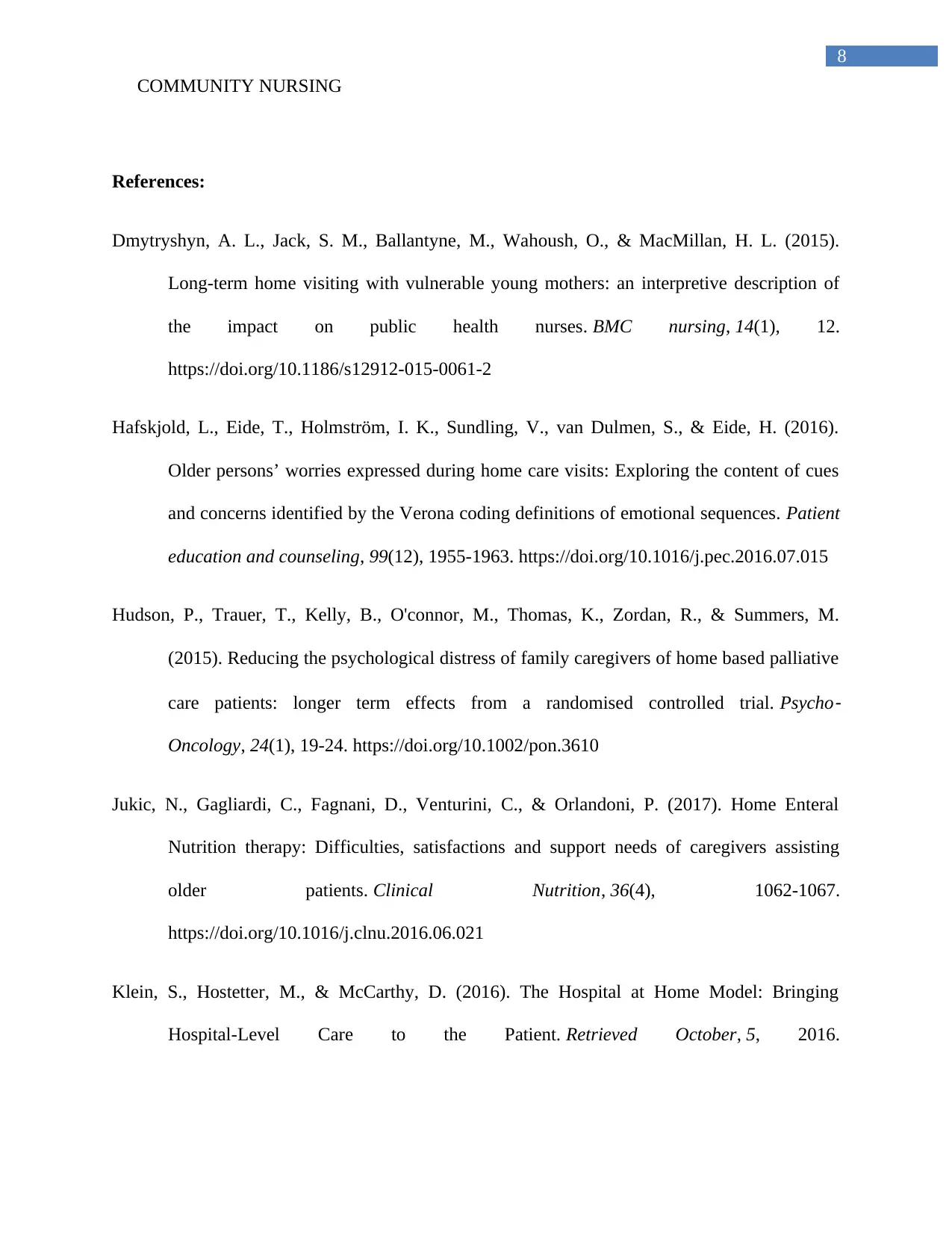
8
COMMUNITY NURSING
References:
Dmytryshyn, A. L., Jack, S. M., Ballantyne, M., Wahoush, O., & MacMillan, H. L. (2015).
Long-term home visiting with vulnerable young mothers: an interpretive description of
the impact on public health nurses. BMC nursing, 14(1), 12.
https://doi.org/10.1186/s12912-015-0061-2
Hafskjold, L., Eide, T., Holmström, I. K., Sundling, V., van Dulmen, S., & Eide, H. (2016).
Older persons’ worries expressed during home care visits: Exploring the content of cues
and concerns identified by the Verona coding definitions of emotional sequences. Patient
education and counseling, 99(12), 1955-1963. https://doi.org/10.1016/j.pec.2016.07.015
Hudson, P., Trauer, T., Kelly, B., O'connor, M., Thomas, K., Zordan, R., & Summers, M.
(2015). Reducing the psychological distress of family caregivers of home based palliative
care patients: longer term effects from a randomised controlled trial. Psycho
‐
Oncology, 24(1), 19-24. https://doi.org/10.1002/pon.3610
Jukic, N., Gagliardi, C., Fagnani, D., Venturini, C., & Orlandoni, P. (2017). Home Enteral
Nutrition therapy: Difficulties, satisfactions and support needs of caregivers assisting
older patients. Clinical Nutrition, 36(4), 1062-1067.
https://doi.org/10.1016/j.clnu.2016.06.021
Klein, S., Hostetter, M., & McCarthy, D. (2016). The Hospital at Home Model: Bringing
Hospital-Level Care to the Patient. Retrieved October, 5, 2016.
COMMUNITY NURSING
References:
Dmytryshyn, A. L., Jack, S. M., Ballantyne, M., Wahoush, O., & MacMillan, H. L. (2015).
Long-term home visiting with vulnerable young mothers: an interpretive description of
the impact on public health nurses. BMC nursing, 14(1), 12.
https://doi.org/10.1186/s12912-015-0061-2
Hafskjold, L., Eide, T., Holmström, I. K., Sundling, V., van Dulmen, S., & Eide, H. (2016).
Older persons’ worries expressed during home care visits: Exploring the content of cues
and concerns identified by the Verona coding definitions of emotional sequences. Patient
education and counseling, 99(12), 1955-1963. https://doi.org/10.1016/j.pec.2016.07.015
Hudson, P., Trauer, T., Kelly, B., O'connor, M., Thomas, K., Zordan, R., & Summers, M.
(2015). Reducing the psychological distress of family caregivers of home based palliative
care patients: longer term effects from a randomised controlled trial. Psycho
‐
Oncology, 24(1), 19-24. https://doi.org/10.1002/pon.3610
Jukic, N., Gagliardi, C., Fagnani, D., Venturini, C., & Orlandoni, P. (2017). Home Enteral
Nutrition therapy: Difficulties, satisfactions and support needs of caregivers assisting
older patients. Clinical Nutrition, 36(4), 1062-1067.
https://doi.org/10.1016/j.clnu.2016.06.021
Klein, S., Hostetter, M., & McCarthy, D. (2016). The Hospital at Home Model: Bringing
Hospital-Level Care to the Patient. Retrieved October, 5, 2016.
⊘ This is a preview!⊘
Do you want full access?
Subscribe today to unlock all pages.

Trusted by 1+ million students worldwide
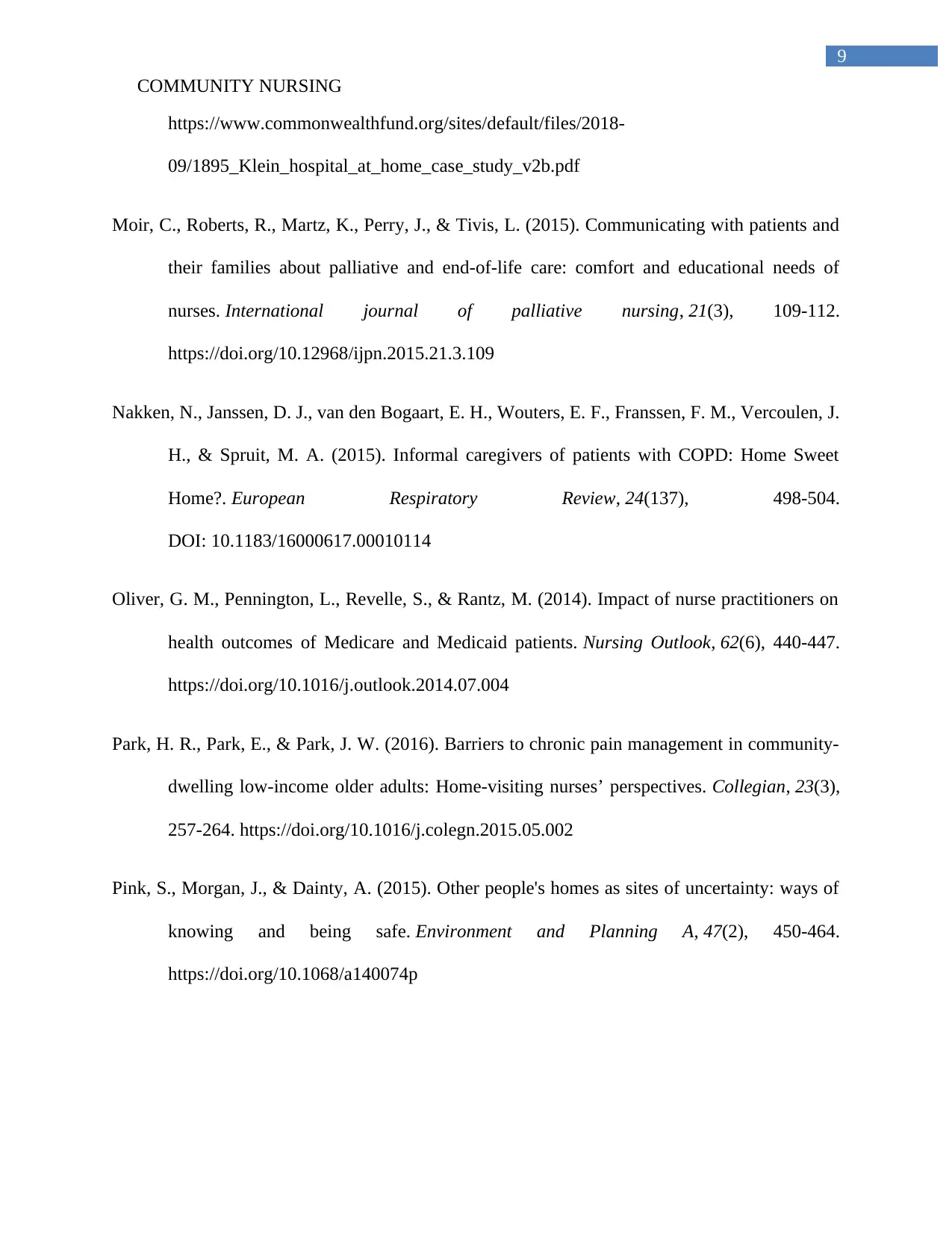
9
COMMUNITY NURSING
https://www.commonwealthfund.org/sites/default/files/2018-
09/1895_Klein_hospital_at_home_case_study_v2b.pdf
Moir, C., Roberts, R., Martz, K., Perry, J., & Tivis, L. (2015). Communicating with patients and
their families about palliative and end-of-life care: comfort and educational needs of
nurses. International journal of palliative nursing, 21(3), 109-112.
https://doi.org/10.12968/ijpn.2015.21.3.109
Nakken, N., Janssen, D. J., van den Bogaart, E. H., Wouters, E. F., Franssen, F. M., Vercoulen, J.
H., & Spruit, M. A. (2015). Informal caregivers of patients with COPD: Home Sweet
Home?. European Respiratory Review, 24(137), 498-504.
DOI: 10.1183/16000617.00010114
Oliver, G. M., Pennington, L., Revelle, S., & Rantz, M. (2014). Impact of nurse practitioners on
health outcomes of Medicare and Medicaid patients. Nursing Outlook, 62(6), 440-447.
https://doi.org/10.1016/j.outlook.2014.07.004
Park, H. R., Park, E., & Park, J. W. (2016). Barriers to chronic pain management in community-
dwelling low-income older adults: Home-visiting nurses’ perspectives. Collegian, 23(3),
257-264. https://doi.org/10.1016/j.colegn.2015.05.002
Pink, S., Morgan, J., & Dainty, A. (2015). Other people's homes as sites of uncertainty: ways of
knowing and being safe. Environment and Planning A, 47(2), 450-464.
https://doi.org/10.1068/a140074p
COMMUNITY NURSING
https://www.commonwealthfund.org/sites/default/files/2018-
09/1895_Klein_hospital_at_home_case_study_v2b.pdf
Moir, C., Roberts, R., Martz, K., Perry, J., & Tivis, L. (2015). Communicating with patients and
their families about palliative and end-of-life care: comfort and educational needs of
nurses. International journal of palliative nursing, 21(3), 109-112.
https://doi.org/10.12968/ijpn.2015.21.3.109
Nakken, N., Janssen, D. J., van den Bogaart, E. H., Wouters, E. F., Franssen, F. M., Vercoulen, J.
H., & Spruit, M. A. (2015). Informal caregivers of patients with COPD: Home Sweet
Home?. European Respiratory Review, 24(137), 498-504.
DOI: 10.1183/16000617.00010114
Oliver, G. M., Pennington, L., Revelle, S., & Rantz, M. (2014). Impact of nurse practitioners on
health outcomes of Medicare and Medicaid patients. Nursing Outlook, 62(6), 440-447.
https://doi.org/10.1016/j.outlook.2014.07.004
Park, H. R., Park, E., & Park, J. W. (2016). Barriers to chronic pain management in community-
dwelling low-income older adults: Home-visiting nurses’ perspectives. Collegian, 23(3),
257-264. https://doi.org/10.1016/j.colegn.2015.05.002
Pink, S., Morgan, J., & Dainty, A. (2015). Other people's homes as sites of uncertainty: ways of
knowing and being safe. Environment and Planning A, 47(2), 450-464.
https://doi.org/10.1068/a140074p
Paraphrase This Document
Need a fresh take? Get an instant paraphrase of this document with our AI Paraphraser
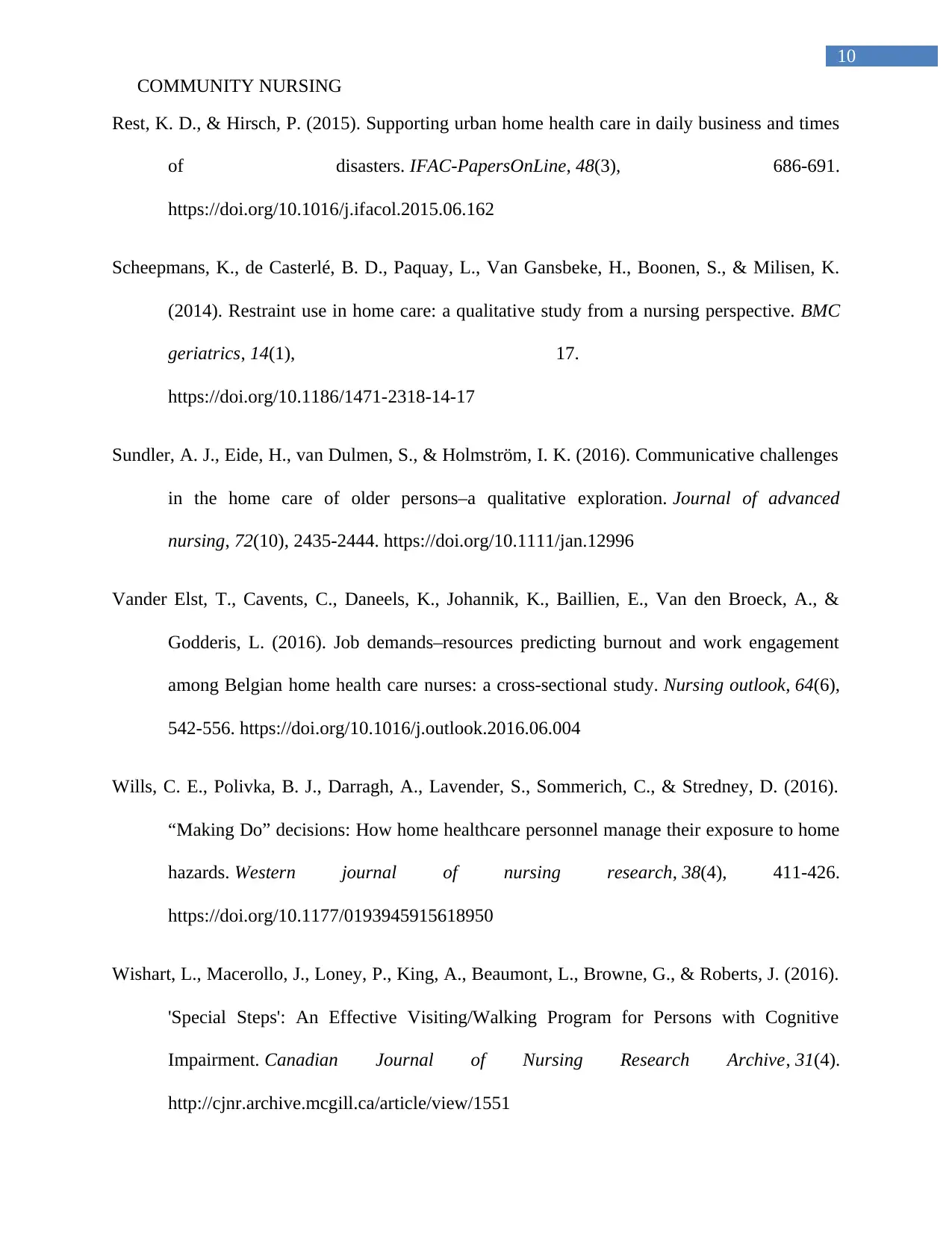
10
COMMUNITY NURSING
Rest, K. D., & Hirsch, P. (2015). Supporting urban home health care in daily business and times
of disasters. IFAC-PapersOnLine, 48(3), 686-691.
https://doi.org/10.1016/j.ifacol.2015.06.162
Scheepmans, K., de Casterlé, B. D., Paquay, L., Van Gansbeke, H., Boonen, S., & Milisen, K.
(2014). Restraint use in home care: a qualitative study from a nursing perspective. BMC
geriatrics, 14(1), 17.
https://doi.org/10.1186/1471-2318-14-17
Sundler, A. J., Eide, H., van Dulmen, S., & Holmström, I. K. (2016). Communicative challenges
in the home care of older persons–a qualitative exploration. Journal of advanced
nursing, 72(10), 2435-2444. https://doi.org/10.1111/jan.12996
Vander Elst, T., Cavents, C., Daneels, K., Johannik, K., Baillien, E., Van den Broeck, A., &
Godderis, L. (2016). Job demands–resources predicting burnout and work engagement
among Belgian home health care nurses: a cross-sectional study. Nursing outlook, 64(6),
542-556. https://doi.org/10.1016/j.outlook.2016.06.004
Wills, C. E., Polivka, B. J., Darragh, A., Lavender, S., Sommerich, C., & Stredney, D. (2016).
“Making Do” decisions: How home healthcare personnel manage their exposure to home
hazards. Western journal of nursing research, 38(4), 411-426.
https://doi.org/10.1177/0193945915618950
Wishart, L., Macerollo, J., Loney, P., King, A., Beaumont, L., Browne, G., & Roberts, J. (2016).
'Special Steps': An Effective Visiting/Walking Program for Persons with Cognitive
Impairment. Canadian Journal of Nursing Research Archive, 31(4).
http://cjnr.archive.mcgill.ca/article/view/1551
COMMUNITY NURSING
Rest, K. D., & Hirsch, P. (2015). Supporting urban home health care in daily business and times
of disasters. IFAC-PapersOnLine, 48(3), 686-691.
https://doi.org/10.1016/j.ifacol.2015.06.162
Scheepmans, K., de Casterlé, B. D., Paquay, L., Van Gansbeke, H., Boonen, S., & Milisen, K.
(2014). Restraint use in home care: a qualitative study from a nursing perspective. BMC
geriatrics, 14(1), 17.
https://doi.org/10.1186/1471-2318-14-17
Sundler, A. J., Eide, H., van Dulmen, S., & Holmström, I. K. (2016). Communicative challenges
in the home care of older persons–a qualitative exploration. Journal of advanced
nursing, 72(10), 2435-2444. https://doi.org/10.1111/jan.12996
Vander Elst, T., Cavents, C., Daneels, K., Johannik, K., Baillien, E., Van den Broeck, A., &
Godderis, L. (2016). Job demands–resources predicting burnout and work engagement
among Belgian home health care nurses: a cross-sectional study. Nursing outlook, 64(6),
542-556. https://doi.org/10.1016/j.outlook.2016.06.004
Wills, C. E., Polivka, B. J., Darragh, A., Lavender, S., Sommerich, C., & Stredney, D. (2016).
“Making Do” decisions: How home healthcare personnel manage their exposure to home
hazards. Western journal of nursing research, 38(4), 411-426.
https://doi.org/10.1177/0193945915618950
Wishart, L., Macerollo, J., Loney, P., King, A., Beaumont, L., Browne, G., & Roberts, J. (2016).
'Special Steps': An Effective Visiting/Walking Program for Persons with Cognitive
Impairment. Canadian Journal of Nursing Research Archive, 31(4).
http://cjnr.archive.mcgill.ca/article/view/1551
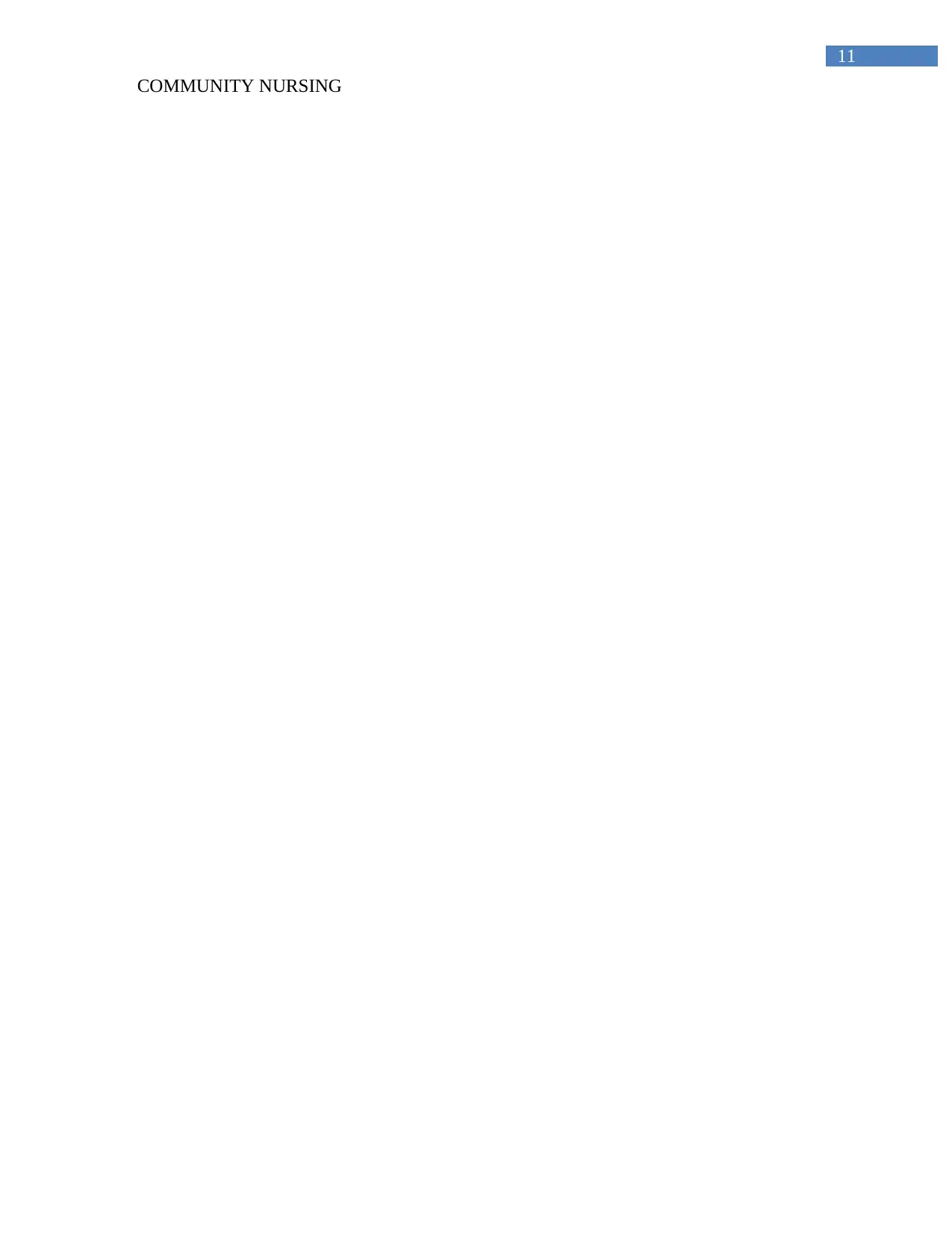
11
COMMUNITY NURSING
COMMUNITY NURSING
⊘ This is a preview!⊘
Do you want full access?
Subscribe today to unlock all pages.

Trusted by 1+ million students worldwide
1 out of 12
Related Documents
Your All-in-One AI-Powered Toolkit for Academic Success.
+13062052269
info@desklib.com
Available 24*7 on WhatsApp / Email
![[object Object]](/_next/static/media/star-bottom.7253800d.svg)
Unlock your academic potential
Copyright © 2020–2025 A2Z Services. All Rights Reserved. Developed and managed by ZUCOL.




